You have no items in your cart. Want to get some nice things?
Go shopping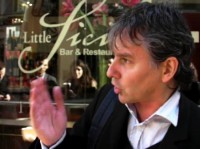 This walk was put together by Heiko Khoo, who runs the Karl Marx Walking Tour in Soho, London, a tour that gives a full introduction to Marx’s ideas, legacy and life in London. Find out more at their website.
This walk was put together by Heiko Khoo, who runs the Karl Marx Walking Tour in Soho, London, a tour that gives a full introduction to Marx’s ideas, legacy and life in London. Find out more at their website.
You can follow this walk on our interactive Google Map below, or read about the places visited in the accompanying article. Nearest tube stations: Chalk Farm, Camden Town, Kentish Town West, Gospel Oak, Hampstead Heath.
View Karl Marx and Friedrich Engels in Camden, London in a larger map
Karl Marx and Friedrich Engels transformed the world. Their ideas about economics, socialism and society changed the way we think forever, influencing everything from how we view history to how nations are governed. It’s a well-known London fact that Karl Marx is buried in Highgate Cemetery, but most of us don’t know much else about one of the world’s most famous German authors’ time in London. Our walk around his old haunts in Camden will take you through Marx’s years here, his relationship with his lifelong friend and financial supporter Friedrich Engels, his greatest writing, and his sad death.
Marx came to London in 1849, exiled from his native Germany and from France as a political threat. He remained here for the rest of his life, learning English so that he could write in for English language newspapers, sometimes living in extreme poverty (only three of his seven children survived into adulthood). He was largely supported by his friend Engels. The headquarters of the Communist League also moved to London, and the city became an international centre of the socialist movement.
Marx was from a middle class family. A writer of fiction as well as his best know philosophical works, Marx had studied in Bonn and Berlin, becoming involved in radical left-wing politics. He began to develop his theory that societies naturally go through a process of class struggle, a war between the owners and the workers, and that capitalism would be overthrown by socialism and then communism. He called for the working classes to fight to bring this about.
Marx and Engels met on the radical scene in Paris in 1843. Engels had already lived in England, working for his family business in Manchester, where he wandered the slums, researching his work The Conditions of the Working Class in England in 1844. It was this book that persuaded Marx that the working classes would be crucial in the final revolution that would bring about communism. The two would collaborate on The Communist Manifesto in 1848.
Engels moved with Marx to London, going back to work in Manchester in order to support himself and Marx, whom he saw as an important thinker. During their time in the city they wrote some of their most important works, and were both leading figures in the International socialist movement, putting them under scrutiny from the British authorities.
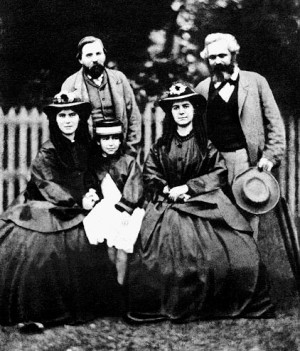
1. Escaping Poverty: Marx at 36 Grafton Terrace (Formerly no. 9)
Click here for the location. Marx moved to London in 1849 after being exiled from France and Germany as a political thread. His first years in the city were plagued by dire poverty and squalor. In October 1856 the Marx household moved here, to Grafton Terrace near Chalk Farm, escaping the miseries of their former rooms in Dean Street, Soho, where three of their children had died. The move was financed by Marx’s friend Friedrich Engels, who had sold his share in a Manchester factory to fund their joint studies.
The new house had eight rooms, enabling the Marx children to entertain other children from the neighbourhood. Initially, their life was radically improved, but Marx was soon overspending the money he and his wife had inherited from his father, and was soon reduced to begging cash from Engels again. The exterior of building has an appropriate red door, and it remains little changed from when Marx lived there.
The leader of the German workers’ movement, Ferdinand Lassalle, stayed here in 1862 while he was visiting the International Exhibition. He engaged in profligate spending whilst Marx was completely broke, infuriating Marx.
Marx would trundle off from here, taking the omnibus to the British Museum, where he would spend hours in the reading room, researching and writing his great life’s work, Das Kapital.
2. Death of Marx: 44 Maitland Park Road
Click here for the location. The house is gone, but a plaque on a council flat marks the spot where the Marx family, now made up of Marx himself, his wife Jenny von Westphalen, his daughter Eleanor and their maid Helene Demuth, lived from March 1875, a smaller house than their previous address.
Marx was suffering from liver complaints, lung problems, and numerous minor but extremely uncomfortable ailments.
Jenny died on 2nd December 1881, but Marx was so ill himself that his doctor forbade him to attend the funeral.
Engels called on Marx at half past two in the afternoon on 14th March. He left Marx in his room for a few minutes, finding him dead on his return. Marx was buried in Highgate Cemetery on 17th March 1883, his death going largely unnoticed. He was officially a “stateless person”, someone with no nationality, a with only a handful of mourners at his funeral. Engels said in his speech;
“On the 14th of March, at a quarter to three in the afternoon, the greatest living thinker ceased to think. He had been left alone for scarcely two minutes, and when we came back we found him in his armchair, peacefully gone to sleep—but forever.”
A hundred years later, 37% of the world was living under governments ruling in Marx’s name. We will never know for certain, but as a man who believed that true social change is brought about by natural social development rather than the actions of “a handful of men”, it seems likely that these regimes would have horrified him.
3. New-found Prosperity: Location of 1 Modena Villas
Click here for the location. The Marx household moved here in March 1864, paying £65 a year in rent. Marx had inherited £820 from Willhelm Wolf, to whom he duly dedicated the first volume of Das Kapital, which was finally ready for publication in 1867 after more than 16 years struggle with the complexities of economics.
In his new-found prosperity, Marx wrote to his uncle Lion Philips claiming that he’d been successfully speculating on the stock market and made more than £400. This was indeed the family’s most prosperous period, when the children could entertain and life was good. It was also Marx’s most productive period in politics and publication.
Marx was hurled into hectic participation in political life when the socialist organisation First International was created in September 1864. Marx’s collaborators organized protests in Hyde Park in 1866, calling for the extension of the male franchise. The Paris Commune of 1871 made Marx the centre of political attention, and he was condemned as the Pope of Communism.
It was during his time here that his clash with the Anarchist leader Michael Bakunin came to a head.
4. The Good Life: Engels at 122 Regent’s Park Road
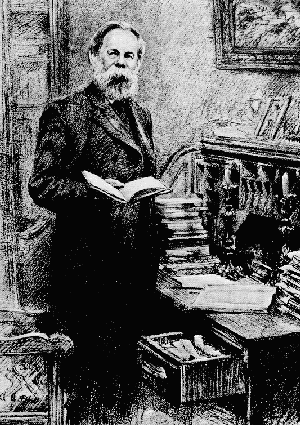
Click here for the location. In 1870, Frederich Engels sold his share of his Manchester factory Ermen and Engels, overjoyed at finally giving up the “shitty business”. He made £12,500 from the sale, with which he moved to this house, also supporting the impoverished Marx family with the cash.
Karl Marx’s wife Jenny found the house for the Engels family, writing, “I have now found a house, which charms all of us because of its wonderful open situation. It is next to Primrose Hill, so all the front rooms have the finest and openest view and air. And round about, in the side streets, there are shops of all sorts, so your wife will be able to buy everything herself.”
It was in this house that Engels wrote his main works and ploughed his way through Marx’s illegible scribbles, producing volumes two and three of Das Kapital, as well as his own famous works, Anti-Duhring, Socialism Utopian and Scientific, and The Origin of the Family, Private Property and the State.
It’s a five minute walk from here to the house Karl Marx and his family lived in at the time, a trip Engels would make daily. They loved to take long walks up to Hampstead Heath for picnics, with a compulsory stop at the Jack Straw’s Castle pub.
British police and foreign spies would observe the comings and goings at this strange house from the front of the pub opposite. Engels was relaxed about the attention. “The imbeciles evidently think we are manufacturing dynamite, when in reality we are discussing whisky.”
Engels loved the good life, entertaining deep into the night with large quantities of claret and champagne laid on. In 1878, he married Lizzy Burns on her deathbed in the house, the younger sister of his lifelong partner Mary, who had died in 1863.
After Marx died in 1883, Helene Demuth, Marx’s maid, moved worked for Engels. When she died, Sophie Kautsky, the estranged wife of the German Social Democratic leader Karl Kautsky moved in, much to the alarm of Eleanor Marx, who feared she was deliberately isolating Engels.
Engels became a leading figure in the new socialist organization Second International, created in 1889. It eventually included the German Social Democrats, the British Labour Party and the Russian Social Democratic Labour Party. This house acted as both command centre and intellectual hub of the international Labour movement, with Engels becoming known as “The Grand Lama of the Regent’s Park Road”,
Visiting this house was a pilgrimage for young revolutionaries. All manner of socialist newspapers in many languages would arrive to be studied by Engels every day.
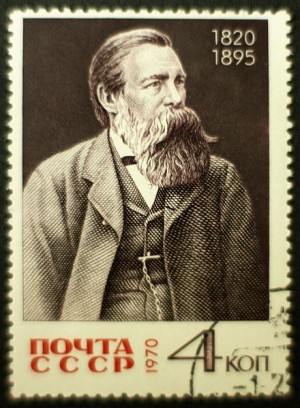
5. Engels’s Death: 41 Regents Park Road
Click here for the location. Engels moved to this house in 1894, but would only spend a year here before his death. He died in this house of cancer of the throat on August 5 1895. His last words were said to have included a confession that Helene Demuth’s son Freddy was Marx’s child, but this story has always been contested.
His body was taken to Woking Crematorium after being given a send-off at Waterloo Station by socialist delegations from all over Europe. A small group of friends and comrades, including Eleanor Marx, Eduard Bernstein and Karl Kautsky rowed out to sea near Eastbourne and scattered his ashes. Engels wanted no monument, statue or tombstone. In the years since his death, thousands of statues of Engels and Marx have been erected all over Eastern Europe, China and the Soviet Union.
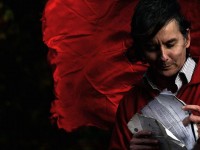 Thanks to Heiko Khoo for the design and information for this walk. The Karl Marx Walking Tour in Soho, London gives a full introduction to Marx’s ideas, legacy and life in London. Find out more at their website.
Thanks to Heiko Khoo for the design and information for this walk. The Karl Marx Walking Tour in Soho, London gives a full introduction to Marx’s ideas, legacy and life in London. Find out more at their website.

About Emily Cleaver
Emily Cleaver is Litro's Online Editor. She is passionate about short stories and writes, reads and reviews them. Her own stories have been published in the London Lies anthology from Arachne Press, Paraxis, .Cent, The Mechanics’ Institute Review, One Eye Grey, and Smoke magazines, performed to audiences at Liars League, Stand Up Tragedy, WritLOUD, Tales of the Decongested and Spark London and broadcasted on Resonance FM and Pagan Radio. As a former manager of one of London’s oldest second-hand bookshops, she also blogs about old and obscure books. You can read her tiny true dramas about working in a secondhand bookshop at smallplays.com and see more of her writing at emilycleaver.net.





How about a sunny bank holiday London stroll? Our walk traces the lives of Karl Marx and Friedrich Engels in Camden. https://t.co/JbS0xumkmS
Political “threat”, rather than “thread” no?
Here: “Marx moved to London in 1849 after being exiled from France and Germany as a political thread.”
https://t.co/YEaKfQEYcv
@humbertobeck Beck! Come to London https://t.co/4NyMylQwZ6